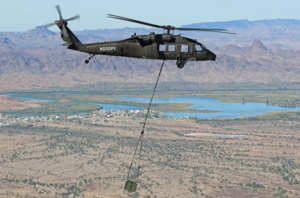After conducting another series of unmanned Black Hawk flights using Sikorsky’s [LMT] autonomy software, DARPA’s lead official for the program said he’s “very confident” the technology will transition to the Army.
Stuart Young, DARPA’s program manager for the Aircrew Labor In-cockpit Automation System or ALIAS project, said last month’s demonstrations at Yuma Proving Ground in Arizona during the Army’s Project Convergence (PC) experiment were likely the last under the ALIAS effort as it looks to transfer to the military services and potential commercial applications.

“Essentially, we have demonstrated that it’s now possible and we really have [the Army] thinking about what do they want to do with this capability that we have demonstrated. So we’re going to continue to work with the aviation community, the sustainment community and the medical community within the Army to continue developing this capability for missions that they see fit,” Young said Nov. 2. “This is an old program from a DARPA perspective but we really feel like we’ve created an inflection point and it’s a large value proposition. We’re really trying to set the conditions, at this stage of the program, for optimal opportunities for transition to the services and to the commercial sector.”
Young said he believes the unpiloted Black Hawk flights during PC ‘22, which included performing internal and external cargo resupply missions and a rescue operation, “successfully convinced” Army leaders of the technology’s capability as it assesses autonomy requirements for its existing fleet and Future Vertical Lift platforms.
“In working with the Army, we have demonstrated some capabilities that they have requested, both in working with the Future Vertical Lift program and as well as with some of the other entities within the Army, specifically the sustainment community who have the mission of getting logistics to a location on the battlefield,” Young said.
Under the ALIAS program, which DARPA has been running for the past six years, Sikorsky has retrofitted a Black Hawk with its Matrix autonomy technology designed to help reduce pilot workload.
DARPA and Sikorsky conducted the first fully autonomous Black Hawk flights with no pilots aboard at Ft. Campbell in Kentucky in February, which included taking off and landing autonomously and conducting a simulated obstacle avoidance scenario (Defense Daily, Feb. 9).
Young has previously said he anticipates the technology transitioning to the Army in the near future as the service anticipates potential use cases from aircrew augmentation to potential completely autonomous operations (Defense Daily, Nov. 12 2021).
Igor Cherepinsky, director of Sikorsky Innovations, told reporters retrofitting a UH-60 for a pilotless configuration could take, based on varying factors, from “a few weeks to two months” and says it would cost “a fairly small fraction” of the total aircraft costs.
“If you have use cases where you really don’t want human beings in harm’s way or you really want to extend the service hours of the aircraft, you can now operate the aircraft in an uncrewed fashion where you don’t have anybody onboard,” Cherepinsky said of the Matrix technology for the Black Hawk. “Don’t think of it as remote piloting. It’s really kind of like, ‘Hey, bring the external load here.’ And the aircraft figured out how to bring the external load and drop it off. It really is designed to be operated by non-aviators in that [fully autonomous] mode.”
The latest autonomous Black Hawk flights were held during PC ‘22’s Technology Gateway experiment last month, which featured technologies from 35 companies in the areas of counter unmanned aerial systems, autonomous resupply, and zero trust environments for cyber resilience (Defense Daily, Oct. 19).
Lt. Gen. Thomas Todd, deputy commanding general for acquisition and systems at Army Futures Command, told reporters following the demonstration that DARPA and Sikorsky were able to “execute the missions at ranges that we had not previously seen with payloads we had not previously seen.”
“Being able to launch an aircraft in all weather in a contested, high-threat environment and deliver critical supplies to soldiers in need is huge for us. Sometimes with manned platforms, while we manage risk in an all-weather environment, it’s very difficult for us to take off in what we call ‘zero-zero’ weather–zero ceiling and zero visibility. At the end of the day, we hope to be able to operationalize the capability to lift heavy weights…at ranges in contested environments–potentially maritime environments–that are greater than we’re used to fighting and deliver those supplies ahead of time, ahead of need or, at a minimum, just in time,” Todd said at the time.
Sikorsky noted the unmanned Black Hawk flew 83 miles while carrying 500 pounds of real and simulated blood during the long-endurance medical resupply portion of the unmanned flight demonstration.
The cargo delivery and casualty evacuation portion of the demonstration features the unmanned Black Hawk lifting off with a 2,600-pound external load attached to a 40-foot sling, Sikorsky noted, with the helicopter then flying at 100 knots for 30 minutes towards the designated landing zone.
Maj. Gen. Walter Rugen, director of the of the Army’s FVL Cross-Functional Team, has also previously said he sees opportunities for an autonomous Black Hawk to potentially act as a souped-up version of a UAS capable of extensive distances and cargo-carrying ability for logistics operations.
“On the logistics front, when you look at what ALIAS is doing with the absolutely cargo carrying capacity of the Black Hawk and the range, I haven’t seen a UAS meet that yet. And the fact that ALIAS is doing that and showing that we can carry 6,000 to 8,000 pounds of cargo at our UH-60 ranges, somebody’s going to have to come up with a pretty compelling UAS that’s vertical lift, that can carry that amount and do it at that range,” Rugen also told reporters during last year’s Project Convergence.